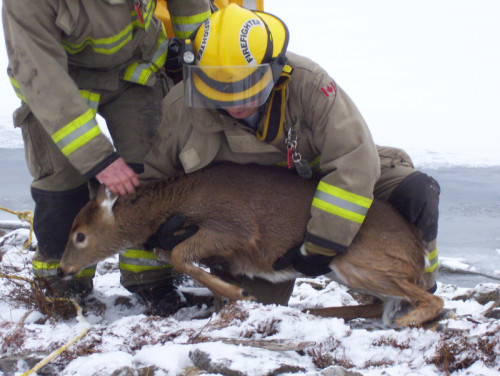Tom Sasvari
The Recorder
EVANSVILLE—Preliminary data indicates that no birds have tested positive for active Newcastle disease or avian influenza infections. This after a collection of samples of cormorants on Manitoulin was carried out by Michigan State University (MSU) researchers.
Dusty Arsnoe, a research associate in the MSU Department of Fisheries and Wildlife, told the Recorder last week, “None of the birds we collected have showed any sign of the disease or virus. No birds tested positive for active Newcastle’s disease or avian influenza infections.”
“We collected samples from 47 cormorants, all at Mike Meeker’s (Meeker’s Aquaculture) in Evansville,” said Mr. Arsnoe. He and MSU wildlife technician Nate Spala were on the Island for two days in May sampling cormorants for avian influenza and Newcastle disease. “This is my first year on Manitoulin, but (MSU researcher) Tiffany Hamilton had been on the Island last year monitoring the movement of the birds, along with a disease component study as well.”
Mr. Arsnoe had told the Recorder previously, “We were sampling for avian influenza and Newcastle disease,” said Mr. Arsnoe. “We have also taken samples from cormorants in areas like Blind River and Kingston, and in the past have sampled in areas like Kenora. Basically what we are trying to do is get a representative sample from different parts of the Great Lakes and a bunch of areas in Michigan. We are interested in finding out how big of a role cormorants play in maintaining or spreading, for example, Newcastle disease. We have seen sporadic outbreaks of the disease, they aren’t predictable, and there was an outbreak last year (2010) while the year before there was no problem. We are also looking at how it affects other birds and try to get a feel as to which birds the disease is spreading from.”
Mr. Arsnoe had indicated previously some of the species of birds that can be affected by either avian influenza or Newcastle disease include mute swans and different duck species. He explained cormorants nest on island colonies so in an area where they have just been hatched we try and sample 40 juvenile birds in the spring and try to sample another 40 adult birds around June, using swabs and collecting blood samples.
In the May 20, 2011 edition of the Recorder Mr. Arsnoe said, “What we have been finding over the last two years is that cormorants have been exposed to both the influenza and Newcastle disease in their lives in our studies of the Great Lakes and Missississippi. Certainly, if populations are higher and the birds are more densely populated in a certain area, it is easier for the virus and the disease to spread, but we don’t take long term data to make this conclusion. However, what we have found is that a lot of birds have been exposed to both at some point in their life.”
Mr. Arsnoe told The Recorder the biggest concern with Newcastle disease is that it can spread through chickens, although there is more of a concern about this in the south. Birds go south in the winter, and Newcastle disease can be potentially bad on chickens and other bird species (and can spread to humans as well). With both Newcastle and avian influenza, disease symptoms can be mild or fairly harmful.
“The point is there are too many cormorants around, and they impact our fish populations on the Island and most of Ontario and the US,” said Mr. Meeker. “And especially with large populations of cormorants or any species whether it be aquatic or land based when they move around a lot, as cormorants do, there is certainly the potential for disease spreading. For instance VHS (viral hemorrhagic septicemia) got established in southern Ontario, Lake Ontario, and it was expected it would move throughout the Great Lakes and has happened, although not to the projections that had been expected in Lake Huron and the North Channel.”
“The birds that are here a good portion of the year fly to destinations south, like Mexico, and there always has been, and will be, a concern with cormorants and their high populations of their affects on the fishery as well as the potential for disease being carried and transferred by them,” said Mr. Meeker. “I can remember about 10 years ago at my fish cages here in Evansville, at this time of year there was an ice film around my nets, and about 30 cormorants who were stuck in the ice, obviously showing signs of being sick. The fact they were here and frozen to the ice is a sign these were sick birds.”
“There is no doubt they (cormorants) have brought some disease into our and other northern areas, and we know their population is great and affects our fish populations,” continued Mr. Meeker. “They are now continuing to move up north and are now bypassing the North Channel into other lakes in Northern Ontario.”
“It is biology 101—cormorants eat too much of our fish, which everyone on Manitoulin Island knows, and they have the potential of transferring diseases as well,” added Mr. Meeker.



